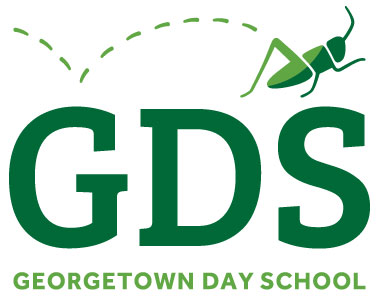On our March snow day, a GDS ninth grader in geometry extended was outside in her boots, aiming a homemade clinometer at the top of a lamppost. Thanks to the weather and the fact that school was canceled, many of her neighbors were outside, too. They watched her curiously. Some walked over to ask what she was doing.
Although she was a little embarrassed—as she hinted to me in school the next day—she explained that she was estimating the height of the lamppost using trigonometry.
Her homemade clinometer, a string attached to a protractor and a small weight, measured the angle of elevation from her eye to the top of the lamppost. To solve for the height of the lamppost, she had to apply trigonometry to the right triangle formed by the ground, the lamppost, and her line of sight. She formed two different right triangles by moving forward or back and finding a new angle of elevation. Comparing her results allowed her to get a sense of the method’s accuracy.
To get an even better sense of her accuracy, though, she then found the height of the lamppost in two additional ways, both of which rely on similar triangles. These other methods might involve a mirror, the lamppost’s shadow, rulers, or another homemade tool called a wile. In the end, she compared her results to determine the range of her outcomes and by what percentage they differed.
This is my second year assigning this project to my students, and each year students’ results have varied widely. Some students’ measurements differ by just a couple of percentage points, which both they and I find surprising and impressive. Other students find their numbers just won’t turn out—their calculated heights differ by over 100%. What is the real height of the post? Which answer is closest? What went wrong? Some frustrated students have asked me to answer these questions. Sometimes, I can point out a calculation error that clears up the issue. Other times, I can’t. And I certainly don’t know the real height of the object.
My hope for this project is that it reinforces in a real way two points I try to emphasize in my classes:
- There is always more than one way to solve a problem.
- The authority lies in the math, not in the teacher.
Anyone who has taken geometry will probably remember proofs (perhaps not fondly). Though proofs might seem about as different as it gets from the lamppost project, they help me reinforce these same two key points in class. First, students know when they “get” a proof or not; it’s very difficult to make a hopeful leap in a proof. They don’t need me to tell them whether or not they’re “right.” Second, some proofs can be done in three steps or ten. Neither approach is better. A successful proof is a successful proof.
As students begin their high school mathematics careers, they sooner or later figure out that they may not be using each new theorem in their future professions. The goal, then, is developing as problem solvers, through proofs, projects, and discovering new concepts in class.
A successful problem solver later in life probably won’t just work alone. By emphasizing multiple methods for solving problems, I hope to allow students to gain confidence in their own creative methods but also to appreciate the diverse thinking of their classmates. Even when you’ve found the right answer, there’s more to learn.


